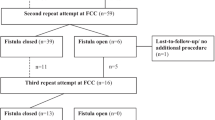Abstract
Introduction and hypothesis
The objectives of this study are to analyze the surgical outcomes of women undergoing obstetric fistula repair operations at the ECWA Evangel VVF Center, Jos, Nigeria, and to identify factors associated with postoperative urinary continence.
Methods
Sociodemographic and clinical data were abstracted retrospectively from the Center’s database for patients who underwent vesicovaginal fistula (VVF) repair operations. These data were compared with clinical outcome (“wet” or “dry”) at the time of hospital discharge.
Results
From August 1998 to April 2004, 1,084 fistula repair operations were performed on 926 patients. A vaginal approach was used in 90.1% of cases, and postsurgical continence was achieved in 70.5% of patients. Continence was more likely in patients with an intact urethra, an upper or midvaginal fistula, and less fibrosis than in those patients who remained wet.
Conclusions
Two thirds of patients with obstetric fistulas can be cured, with complete restoration of continence and low surgical morbidity, using a transvaginal surgical approach.
Similar content being viewed by others

References
Tahzib F (1983) Epidemiological determinants of vesicovaginal fistulas. Br J Obstet Gynaecol 90:387–391
Wall LL (1998) Dead mothers and injured wives: the social context of maternal morbidity and mortality among the Hausa of northern Nigeria. Stud Fam Planning 29:341–359
Tukur J, Jido TA, Uzoho CC (2006) The contribution of gishiri cut to vesicovaginal fistula in Birnin Kudu, northern Nigeria. Af J Urol 12:121–125
Thaddeus S, Maine D (1994) Too far to walk: maternal mortality in context. Soc Sci Med 38:1091–1110
Prevention of Maternal Mortality Network (1995) Situation analyses of emergency obstetric care: examples from eleven operations research projects in West Africa. Soc Sci Med 40(5):657–667
The Prevention of Maternal Mortality Network (1992) Barriers to treatment of obstetric emergencies in rural communities of West Africa. Stud Fam Plann 23:279–291
Arrowsmith SD (1994) Genitourinary reconstruction in obstetric fistulas. J Urol 152:403–406
Wall LL, Karshima JA, Kirschner C, Arrowsmith SD (2004) The obstetric vesicovaginal fistula: characteristics of 899 patients from Jos, Nigeria. Am J Obstet Gynecol 190:1011–1019
Wall LL, Arrowsmith SD (2007) The “continence gap”: a critical concept in obstetric fistula repair. Int Urogynecol J 18:843–844
Ahmad S, Nishtar A, Hafeez GA, Khan Z (2005) Management of vesico-vaginal fistulas in women. Int J Gynaecol Obstet 88:71–75
Hilton P, Ward A (1998) Epidemiological and surgical aspects of urogenital fistulae: a review of 25 years’ experience in southeast Nigeria. Int Urogynecol J 9:189–194
Hilton P (2003) Vesico-vaginal fistulas in develo** countries. Int J Gynaecol Obstet 82:285–295
Evans DH, Madjar S, Politano VA, Bejany DE, Lynne CM, Gousse AE (2001) Interposition flaps in transabdominal vesicovaginal fistula repairs: are they really necessary? Urology 57:670–674
Rangnekar NP, Imdad Ali N, Kaul SA, Pathak HR (2000) Role of the martius procedure in the management of urinary-vaginal fistulas. J Am Coll Surg 191:259–263
Browning A (2006) Lack of value of the Martius fibrofatty graft in obstetric fistula repair. Int J Gynecol Obstet 93:33–37
Acknowledgements
The authors would like to thank Sunday Lengmang, M.D. and Andy Norman, M.D. for their surgical contributions and assistance with the database, and Marci Adams for her editing assistance.
Conflicts of interest
None.
Author information
Authors and Affiliations
Corresponding author
Additional information
Portions of this manuscript have been previously presented: “Vesicovaginal Fistula: our Experience with 1084 Surgical Repairs”, International Continence Society, Christchurch, New Zealand, 29/11/2006.
Rights and permissions
About this article
Cite this article
Kirschner, C.V., Yost, K.J., Du, H. et al. Obstetric fistula: the ECWA Evangel VVF Center surgical experience from Jos, Nigeria. Int Urogynecol J 21, 1525–1533 (2010). https://doi.org/10.1007/s00192-010-1231-0
Received:
Accepted:
Published:
Issue Date:
DOI: https://doi.org/10.1007/s00192-010-1231-0



